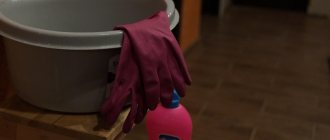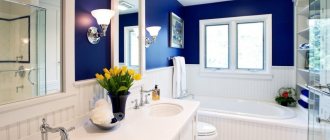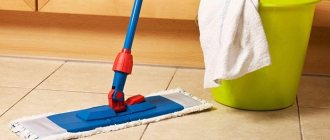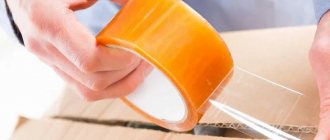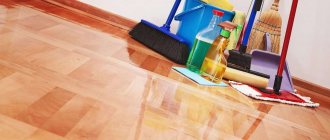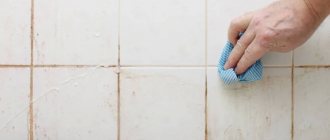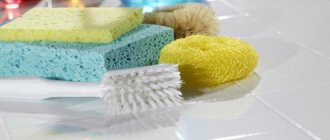Today, floor tiles are a popular coating that is valued by users for its practicality, high durability, and attractive appearance. Caring for it does not require much effort, which makes this material indispensable for finishing kitchens and bathrooms. But if you don’t take care of the tiled surface in a timely manner, then over time the dirt will penetrate deep into the tile and it will be difficult to remove it. In order to know exactly how to wash tiles on the floor, it is advisable to familiarize yourself with the most popular detergents, as well as traditional methods of cleaning such floor coverings. Subsequently, this will allow you to choose the most suitable option for yourself.
Cleaning a tiled floor does not require much time and effort, which is why this coating has become widespread Source sdelai-lestnicu.ru
Why do stains appear on the floor?
The main problem with tiled flooring is the appearance of foreign marks after cleaning. This happens for the following reasons:
- fat has not been previously removed from the surface;
- the base was washed with hard water;
- excessive use of detergent;
- the cloth used was poorly wrung out;
- The water was not changed during the cleaning process.
If you take into account the above-described nuances when carrying out the cleaning process, then there will most likely not be any stains left on the surface of the floor base.
Ceramic tile floors should be washed using glass cleaners and ammonia: they remove stains and add shine to the surface Source i.ytimg.com
Construction dust
The most harmless type of pollution, perhaps, is construction dust; its presence is inevitable when carrying out any repairs, both major and light cosmetic. After repairs, the tiles have to be washed to remove the accumulated layer of dust particles. At the same time, the question becomes relevant - how to wash the tiles and remove dirty stains without damaging its coating.
To begin with, it is recommended to sweep away the dirt with a dry cloth, and if possible, vacuum the surface. This will remove the main layer of dust and large particles that could damage the glaze. If possible, carefully scrape off any hardened finishing materials with a blade. Only after this will it be possible to begin wet cleaning to completely clean the tiled surface.
You can clean the tiles using the following means:
- Soapy water. The simplest, but very effective way. You can use washing powder.
- Water with lemon. Gives shine to a glossy surface and has a pleasant aroma.
- Vinegar. Also diluted in water. Suitable for cleaning serious stains, it also makes the surface shiny and creates a protective film.
- Glass cleaner. A simple, convenient and effective product that allows you to wash away dirt and remove stains from the surface.
Basic products for cleaning tiles from construction dust
How to wash properly
Cleaning a tiled floor properly is not difficult at all. In order for the tiles to simply shine clean later, it is enough to adhere to the following algorithm of actions:
- First of all, clean the surface using the dry method. This can be done using an ordinary broom or vacuum cleaner.
- Using highly effective detergents, perform wet cleaning.
- Add shine to the base.
Important! After completing each stage, you need to carefully inspect the floor in order to detect untreated areas in time. This will save you from having to redo the whole job all over again.
Ceramic tile floors should be washed using glass cleaners and ammonia: they remove stains and add shine to the surface Source i.ytimg.com
Pollution prevention
To some extent, avoiding the unpleasant consequences of repairs in the form of the need to clean the tiles from grout and tile adhesive residues on the floor of the bathroom or kitchen, from traces of primer, paint or whitewash when finishing walls and ceilings, will help with basic steps:
- When carrying out work involving the use of wallpaper paste, primers or various types of paints, the surface of the floor or walls lined with ceramic tiles must be covered with plastic film, paper, cardboard or any other suitable material available. Otherwise, stains from these substances can add a lot of work to your work during the final cleaning of the tiles.
- When installing porcelain tiles or tiles, any remaining adhesive mixture must be immediately removed from their surface with a damp rag or sponge. Cleaning dried adhesive, especially from embossed ceramic tiles, is a labor-intensive task and, in some cases, costly, requiring the use of expensive products.
- Difficult to remove stains can also remain from traces of grout that were not removed from the tile in time. That is, the remaining grout is removed as the work on processing the seams with a fugue is completed.
Use of special detergents
Often, floor tiles are washed using various special products. The choice of the latter should be taken responsibly. After all, most of them have a similar cleaning effect, but some nuances are observed. Before choosing the right composition for yourself, it is recommended that you familiarize yourself with the most popular products.
Silit
Designed for cleaning kitchens and bathrooms, it has excellent cleaning properties at an affordable price. This chemical composition helps to get rid of even old stains, destroys harmful bacteria, and perfectly disinfects the surface being treated.
Silit cleaning agent effectively copes with contaminants such as limescale, rust, soap stains and grease Source cdn.comfy.ua
Milit
A concentrated product created specifically for cleaning kitchens, produced in the form of a spray. It perfectly removes dirt on all types of kitchen surfaces. Additionally, economical consumption and affordable price allow you to significantly save your budget.
Sanitol
Convenient packaging and the presence of a spray bottle ensure economical application of the substance to the base. In this case, no time is required for preliminary preparation. In addition, it is worth noting that the composition does not have a strong odor. The only disadvantage of sanitol is its relatively high cost.
Sanitol has become widespread due to the absence of a strong odor and the presence of a convenient sprayer Source cdn1.ozone.ru
Selena
This product is used for complex cleaning. It allows you to completely rid the surface of greasy stains. To wash dirty tiles you need:
- Dilute the chemical composition in a small amount of water.
- Treat contaminated areas with the resulting liquid.
- Wait about five minutes.
- Remove greasy deposits with a rag.
What is the best way to wash tiled, ceramic, glossy tiles, without streaks, so that they shine?
Any tile, including ceramic tiles (both glossy and matte) can be washed with household or chemical products.
What products can be used to polish tiles to a shine:
For cleaning the bathroom and toilet
Universal and professional products
Detergents and cleaning products
Different types of detergents
Traditional methods
If you are unable to purchase an expensive special cleanser or do not want to use toxic drugs, you can use home remedies. As a rule, they are less efficient, but at the same time they are environmentally friendly. In practice, such recipes are often used.
Vinegar
Regular acetic acid makes an excellent cleaning solution. Cooking method:
- Mix a liter of water with 90 ml of table vinegar.
- Pour the liquid into a spray bottle.
- Treat the stain.
- Rinse off the applied composition with clean water.
- Wipe the surface dry.
Attention! Vinegar essence cannot be used to make a cleanser (due to its high concentration). Food vinegar (9%) is most suitable.
https://m-strana.ru/articles/chem-otmyt-gruntovku-so-stekla/
Ammonia
Making a cleaning composition for floor tiles is very simple. To do this you will need:
- Prepare two liters of an aqueous solution of ammonia. The latter will only need one tablespoon.
- Pour liquid into the sprayer.
- Treat contaminated areas.
- Wait five minutes.
- Wipe the surface with a dry cloth.
Lemon acid
To clean tiles, you can use citric acid instead of vinegar. It needs to be diluted in warm water or poured onto a moistened sponge, then rubbed into the contaminated base.
Important! In addition to removing dirt from a tile floor, citric and acetic acids additionally disinfect it: they get rid of dangerous mold and other harmful organisms.
A solution of citric acid may cause skin irritation, so the day before using it, be sure to wear gloves. Source biotiki.org
Recommendations for cleaning depending on the type of surface
Tiles used for interior decoration are divided into several types according to the type of front surface. Specific cleaning methods should be used for each type of surface.
Unpolished tiles. To clean unpolished surfaces from dust, aqueous solutions and ready-made chemical compositions are used. For more stubborn stains, acetone or solvent will work.
Semi polished tiles. You can wash off ordinary dust from such a surface with a solution of water and washing powder. Paint and primer are removed with solvents.
Polished tiles. Dust is washed off with ordinary warm water. In other cases, scrapers and solvents can be used.
Relief tiles. Tiles with a ribbed surface are much more difficult to clean than regular smooth tiles. In this case, it is better to use an aqueous solution with citric acid for ordinary stains, and steaming and solvents for stubborn stains.
Glazed tiles. It can be easily washed off with warm water without the use of chemicals. It is better to remove paint with a solvent.
Matte tiles. Typically, such material is laid on the floor, since its rough surface does not allow slipping. To clean, make a solution of warm water and washing powder. Stubborn stains are removed with acetone or solvent.
Video description
How to clean the grout between tiles quickly? Top 10 ways to clean tile joints.
Chalk
It is recommended to treat floor coverings made of glossy tiles with ordinary chalk. Procedure:
- Mix chalk and water to form a mushy consistency.
- Apply the prepared mixture to the surface of the tile.
- Remove the resulting layer along with the dirt.
Advice! To make the tiled floor shine, it additionally needs to be wiped with paper.
Chlorine
For those who can tolerate the unpleasant chlorine smell, it is recommended to try the following recipe:
- Dilute a tablespoon of chlorine in 1 liter of water.
- Treat the tiles with the prepared liquid. In this case, it is advisable to use a sprayer.
- Wait about ten minutes.
- Wipe the surface with a clean cloth.
As practice shows, a chlorine solution can easily cope with even stubborn stains. It is extremely important to use rubber gloves when cleaning.
All chlorine-containing compounds are toxic; if they come into contact with the skin or mucous membranes, the affected area should be rinsed thoroughly with running water. Source sib.fm
Tips for using home remedies to clean tiles
- To clean the tiles after repair without harming their appearance, do not forget to test the new cleaning agent on an inconspicuous area.
- Solutions of baking soda and bleach quickly lose their cleaning properties, so you should not prepare them for future use on an industrial scale.
- After cleaning the seams, fill them with sealant, which will protect against contamination for a long time.
Warnings:
- Try to wash the tiles after repairs without using hard wire brushes, which can damage the seams between the tiles.
- To clean tiles made of natural stone (marble, granite, travertine, etc.) after renovation, do not use vinegar under any circumstances. Because acetic acid corrodes the surface of the stone and can cause serious damage. Products with a neutral pH level are ideal for cleaning natural materials.
Cooperating with is reliable and prestigious. The specialists working here are professionals of the highest level. operates throughout Moscow and the Moscow region.
Video description
How to quickly clean grout lines in tile floors.
Melamine sponge
Excellent for removing dirt from glass, tiles, metal, and parquet. Before you start cleaning, you need to moisten it well, and then treat the contaminated area of the floor covering. It is especially effective to use melamine sponge in places where chemicals cannot be used and moisture is not allowed.
White melamine sponge is a licensed product made from special foam that does not contain chemicals or other cleaning and auxiliary substances Source 4.404content.com
Steam cleaner
A very simple, extremely easy to use household appliance. It is best suited for cleaning tiles in the bathroom and kitchen. Under the influence of the hot steam released by the device, the dirt instantly lags behind the base. At the same time, no traces remain on the surface at all. If you strictly adhere to the manufacturer's recommendations, there will most likely not be any major difficulties with cleaning.
Modern steam cleaners are made of stainless steel and therefore do not require the use of distilled water Source karex.ru
Primer
Now let's look at how you can clean ceramic tiles from primer after repair. White stains often remain on floor tiles, since the installation of wall cladding is carried out after it has been laid. It is advisable to spread a protective film on the floor, but this does not always provide a 100% guarantee of protection against stains.
If the primer gets on the tile, it is advisable to wash it off with clean water as quickly as possible. When the substance dries it will harden and it will be much more difficult to wash it off. For this purpose, you can use the following tools:
- special solvent-based remover;
- acetone;
- polyurethane foam;
- fresh primer.
As soon as the stain softens, you can try to clean it off. You can also use a special scraper with a sharp blade, which can be used to remove drops of frozen paint from glass surfaces.
The primer is best washed off before it hardens with clean water or solvent
How to wash flooring without streaks
To ensure that no traces are observed on the tiles after the cleaning process is completed, you must:
- First of all, clean the seams and joints in the corners of the room. Detergent is applied to the latter and left for three to five minutes. Then these areas are treated with a brush, and the remaining cleaning substances are removed with a rag.
- Wash the floor with a special product, after diluting it with water.
- To ensure that the tiles always remain in perfect condition, they should be washed regularly (several times a week).
To care for tiled floors, we recommend purchasing a special mop. Every stain that appears must be washed off in a timely manner. The latter will not allow dirt to penetrate inside the ceramic material and complicate future cleaning.
What can and cannot be used?
The tiles used to decorate walls can be different, but they are always durable and resistant to various types of influences. Many people mistakenly believe that such surfaces will withstand any chemical and mechanical means. However, even the choice of compositions intended for cleaning tiles should be considered carefully.
Most often, people choose finishing materials with a glossy surface. For such a coating, the use of abrasive substances and metal or hard brushes will be detrimental.
These products can quickly clean the tiles in the bathroom, but the small scratches they leave will eventually deprive the tiles of their original shine.
When choosing products for cleaning tiles, you must take into account that the joints between the tiles also require care, but the methods and means of cleaning them must be different. Exposure to acid-containing products will be destructive for building materials used as grout.
It is not recommended to use compositions intended for kitchen or plumbing equipment to clean bathroom tiles from limescale. You should also avoid products containing sand, pumice and fatty components.
After treatment with special cleaning emulsions, the matte tile surface should be coated with wax mastic, which will protect the porous surface from absorbing dirt and also highlight the structure and color of the material.
Careful care of tiles involves using:
- soft sponges;
- wool or felt napkins;
- toothbrushes;
- gentle detergents.
How to clean tile floors from stubborn dirt
If you do not clean the tiles after each new stain, the dirt will dry out and then it will be difficult to remove.
A good remedy for getting rid of grease and rust is an aqueous solution of vinegar (1:1). When using a spray, it should be applied to a dirty surface, then wiped with a microfiber cloth.
Advice! When cleaning tiles, it is unacceptable to use used dish sponges: they can damage the floor base.
Grout restoration
Today, tile ornaments in the form of mosaics or paintings are very popular. Laying such a surface is expensive and durable, but over time the grout loses color and becomes smeared, which makes it necessary to restore it.
We restore grout with special means
During operation, the grout absorbs moisture, grease, and dirt, causing stains to appear or color to change.
Grout restoration
Knowing how to remove stains from dirty grout, you can restore it without replacing the entire finish.
To do this you can use the following tools:
- Eco Mist Grout is a product that does not require rinsing, as it is made on a plant basis. Spray the dirty surface and scrub the grout with a toothbrush. The substance decomposes and erodes on its own over time.
Note! Eco Mist Grout is suitable for cleaning grout in the kitchen.
- Mellerud is a chemical that removes even stubborn grease stains and dirt from grout. Treat the seams, scrub with a brush and be sure to rinse off the product.
Their disadvantage is their high cost. They are not intended for regular use, and not everyone wants to purchase a whole bottle of expensive product for 1 cleaning.
Household chemicals
At home, we use cheaper products that can also be used to restore grout:
- "White". Suitable for cleaning white grout because it has bleaching properties. Pour a little product onto the fabric, treat the seams and rinse.
- Ammonia and vinegar . The products can be used individually or mixed 1:1. Treat contaminated areas with the solution, leave to soak for 15–20 minutes and rinse. Repeat the procedure if necessary.
Whitens more than just clothes
If the grout turns yellow over time, treat it with hydrogen peroxide without rinsing it off. The product will whiten the grout without damaging the tiles.
Partial removal of the top layer of grout
It is necessary to remove the top layer of grout based on the type of material used to process the seams. The cement one is scraped off using a scraper - a chisel with a semicircular tip, and the epoxy one is first treated with chemicals, wait until the top layer dissolves and scrape it off.
Restoration with marker
The marker temporarily covers dirty or gray seams. However, painting is important if there is a grand event with guests, but you do not have time to make repairs. Select a marker of the desired shade and paint over dry seams. However, do not forget that the method will temporarily put the grout in order, so after a month you will still have to restore it in more radical ways.
Removing marker designs from glossy hard surfaces is not that difficult.
How to remove mold
In addition to limescale or dirt, the tiled floor often needs to be cleaned of mold that has formed in the area of the seams. In such a case, you need to prepare a cleaning composition from the following components:
- soda – 1/2 cup;
- vinegar - 1/4 cup;
- ammonia – 1/3 cup;
- water - 7 glasses.
The solution needs to be poured into a container with a spray bottle, then thoroughly treat the affected areas. After some time, the surface should be wiped with a pre-moistened cloth.
Additionally, a mixture of the above ingredients will disinfect the tile surface and get rid of bitumen stains and paint (water-based).
Blackening of the areas between the tiles over the entire surface of the floor or in certain places indicates that fungal bacteria are developing in the pores of the grout Source plitkahelp.com
How to clean fat
Vinegar and baking soda will help thoroughly clean floor tiles from grease accumulations. If the latter are mixed and then applied to a heavily contaminated surface, then after a quarter of an hour all the dirt will dissolve. You just need to clean it with a damp cloth.
In addition, you can get rid of grease on tiles with the help of lemon. It easily removes stubborn stains from many food items. The dirt should be wiped with a lemon slice or treated with juice. Subsequently, even stubborn dirt will dissolve.
General information about products - selection criteria
In comparison with conventional cleaning products, the content of caustic substances in them is many times less than for the products of the group under consideration.
Product types are classified into three categories: acidic, neutral and alkaline. The first group is used to remove complex construction contaminants. In order not to make mistakes when choosing, you need to pay attention to the “pH” indicator - the range of numbers from 0 to 14. Explanation:
- 0-5.5 – acids;
- 5.5-8.5 – neutral substances;
- 8.5-14 – alkalis.
Note! The higher the acidity level, the more effective the product.
Tips for choosing - what to look for
Acidic substances get rid of mineral contaminants (for example, rust, lime and calcium deposits, efflorescence and scale). The product may contain one or a whole complex of acids.
A surfactant is an indicator that combined contaminants can be cleaned. The liquid can prevent corrosion (sometimes inhibitors are added to the composition).
If you need to get rid of heavy mineral deposits and rust from acid-resistant surfaces, then the pH value should vary between 0-2.
Note! Heavy mineral contaminants include cement.
Photo - “Part of a room with brick walls”
If you need to remove lime deposits, rust, remnants of dry building mixtures, efflorescence from hard and chrome-plated surfaces, clean phosphorus, earthenware, brickwork, ceramics, tiles or tiles, then a product with a pH value of 2-5 is required.
If you plan to clean plumbing units, then:
- to remove old stains, foam acid compositions containing oxalic acid are used;
- for everyday cleaning of tiled, ceramic, earthenware, enamel and other coatings, it is better to use a product that contains orthophosphoric acid;
- To eliminate unpleasant odors (rottenness, urine), antibacterial agents with aromatic additives are used.
Important! Acidic solutions are not suitable for marble surfaces.
Product classification
Based on the above information, several statements can be made that will help you understand which product is better to buy.
There are two categories of products: professional and household series. The average volume for cleaning companies is 5 liters, for home use – 500-1000 ml.
If the composition contains one acid, then it is suitable for cleaning specific dirt; if there are several of them, then the product is considered universal and is suitable for a wide range of dirt and surfaces.
Budget home remedies are used, in most cases, only for internal work. The professional series is suitable for facade work.
Depending on the degree of complexity of the contamination, a solution is made (the proportions are indicated in the instructions). Some models come with a natural function - they can be used in their pure form (rare).
Note! When working with acidic liquids, protection is always required: gloves, glasses, clothing, depending on the degree of harm.
Where to buy goods - the best places
If the product is selected for professional use, then it is better to purchase it in construction stores. If the purchase is made for domestic purposes, then you can choose a retail outlet with construction products or household chemicals as the place of purchase, and also order products from an online store.
Ordering online is the easiest way, if time permits, and customer reviews will tell you about the effectiveness of the product.
Rules of care
To avoid having to take drastic measures when cleaning tiled flooring, you must follow these useful recommendations:
- The joints must be treated with silicone sealant. This will prevent mold from forming between the tiles.
- Do not use abrasives to clean tiles. The latter can ruin the floor and deprive it of its beautiful shine.
- To disinfect tiles, it is recommended to use products containing bioenzymes.
- In order for the tiled surface to shine, it must be treated with a special product immediately after washing.
- Rough floors should be washed especially carefully: dirt often gets stuck in the cracks and serves as a breeding ground for germs.
Advice! Cleaning floor tiles cannot be put off for too long. Otherwise, contaminants will penetrate into the structure of the material, and it will not be easy to remove them later.
We wash linoleum after repair
Using the means listed above, linoleum can also be washed. It is better to exclude kerosene - not all types of coating can tolerate it. You cannot use gasoline or ammonia - not all types of linoleum are friendly with them either. These solvents, along with dirt, can also dissolve the protective coating, so we don’t take risks.
To clean linoleum after repair, you need a lot of rags
But you can add laundry soap and turpentine to the list. It is better not to use more aggressive means.
